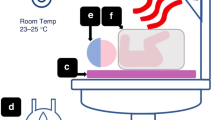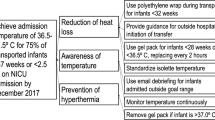Abstract
Maintaining a neutral thermal environment is one of the key physiologic challenges a newborn infant faces after delivery. Attention to detail regarding the management of an infant's neutral thermal environment may lead to improvement in clinical outcome, including improved survival. The details of this management cover a broad spectrum of interventions, from attention to the general environment (such as delivery room temperature) to specific individualized therapies, such as the use of polyethylene occlusive skin wrap. Although an integral part of the routine care of all newborns (whether term or preterm), these interventions have unfortunately received little attention and study. A commitment to greater understanding of these issues and their impact on newborns is essential if we hope to improve their outcome.
This is a preview of subscription content, access via your institution
Access options
Subscribe to this journal
Receive 12 print issues and online access
$259.00 per year
only $21.58 per issue
Buy this article
- Purchase on Springer Link
- Instant access to full article PDF
Prices may be subject to local taxes which are calculated during checkout
Similar content being viewed by others
References
Sedin G . The thermal environment of the newborn infant.In: Fanaroff, Martin's (eds). Neonatal-Perinatal Medicine: Diseases of the Fetus and Infant,8th edn. Mosby Elsevier: St Louis, MO, 2006, pp 585–597.
Knobel R, Holditch-Davis D . Thermoregulation and heat loss prevention after birth and during neonatal intensive care unit stabilization of extremely low birth weight infants. J Obstet Gynecol Neonatal Nurs 2007; 36: 280–287.
Guyton A, Hall J . Textbook of Medical Physiology,11th edn. W.B. Saunders: Philadelphia, PA, 2006.
Hammarlund K, Sedin G . Transepidermal water loss in newborn infants: III. Relation to gestation age. Acta Paediatrica Scandinavica 1979; 68: 795–801.
Stern L . The newborn infant and his thermal environment. Curr Probl Pediatr 1970; 1: 1–29.
Stern L, Lees MH, Leduc J . Environmental temperature, oxygen consumption and catecholamine excretion in newborn infants. Pediatrics 1965; 36: 367.
Day R, Caliguiri L, Kamenski C, Ehrlich F . Body temperature and survival of premature infants. Pediatrics 1964; 34: 171–181.
Silverman W, Fertig J, Berger A . The influence of the thermal environment upon the survival of newly born premature infants. Pediatrics 1958; 22: 876–886.
Department of Reproductive Health and Research (RHR), World Health Organization. Thermal Protection of the Newborn: A Practical Guide (WHO/RHT/MSM/97.2). World Health Organization: Geneva, 1997.
Knobel R, Wimmer J, Holbert D . Heat loss prevention for preterm infants in the delivery room. J Perin 2005; 25: 304–309.
Roberts JR . Use of a Stockinet Cap on Premature Infants After Delivery (dissertation). Texas Woman's University: Denton (TX), 1981.
Bergman NJ, Linley LL, Fawcus SR . Randomized controlled trial of skin-to-skin contact from birth versus conventional incubator for physiological stabilization in 1200- to 2199 gram newborns. Acta Paediatrica 2004; 93: 779–785.
Baker JP . The incubator controversy: pediatricians and the origins of premature infant technology in the United States, 1890 to 1910. Pediatrics 1991; 87: 654–662.
Flenady VJ, Woodgate PG . Radiant warmers versus incubators for regulating body temperature in newborn infants. Cochrane Database Syst Rev 2003,Issue 4. Art. No.: CD000435.DOI:10.1002/14651858.CD000435.
Brennan AB . Effect of Sodium Acetate Transport Mattresses on Admission Temperatures Of Infants ⩽1,500 Grams (dissertation). University of Florida: Gainesville (FL), 1996.
Vohra S, Grent G, Campbell V, Abbott M, Whyte R . Effect of polyethylene occlusive skin wrapping on heat loss in very low birth weight infants at delivery: a randomized trial. J Pediatr 1999; 134: 547–551.
Vohra S, Roberts R, Zhang B, Janes M, Schmidt B . Heat loss prevention (HeI.P) in the delivery room: a randomized controlled trial of polyethylene occlusive skin wrapping in very preterm infants. J Pediatr 2004; 145: 750–753.
McCall EM, Alderdice FA, Halliday HL, Jenkins JG, Vohra S . Interventions to prevent hypothermia at birth in preterm and/or low birthweight babies. Cochrane Database Syst Rev 2005, Issue 1. Art. No.: CD004210.DOI: 10.1002/14651858.CD004210.pub2.
American Academy of Pediatrics and American Heart Association (2005). Summary of major changes to the guidelines 2005 AAP/AHA guidelines for neonatal resuscitation. Available at: www.aap.org/nrp/nrpmain.html Accessed 17 October 2006.
Author information
Authors and Affiliations
Corresponding author
Rights and permissions
About this article
Cite this article
Soll, R. Heat loss prevention in neonates. J Perinatol 28 (Suppl 1), S57–S59 (2008). https://doi.org/10.1038/jp.2008.51
Published:
Issue Date:
DOI: https://doi.org/10.1038/jp.2008.51
Keywords
This article is cited by
-
Embrace versus Cloth Wrap in preventing neonatal hypothermia during transport: a randomized trial
Journal of Perinatology (2021)
-
Thermal imaging applications in neonatal care: a scoping review
BMC Pregnancy and Childbirth (2019)
-
New architectural design of delivery room reduces morbidity in preterm neonates: a prospective cohort study
BMC Pregnancy and Childbirth (2016)
-
Effect of early skin-to-skin contact following normal delivery on incidence of hypothermia in neonates more than 1800 g: randomized control trial
Journal of Perinatology (2014)
-
Thermal protection of the newborn in resource-limited environments
Journal of Perinatology (2012)



